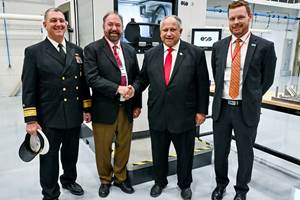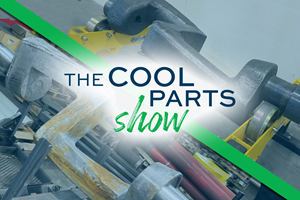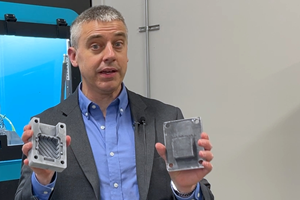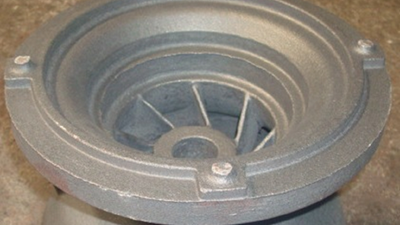Video: Additive Manufacturing as an Alternative to Casting
Daan Kersten of Additive Industries discusses the promise of metal AM for production. Cost per piece can be lower than many expect.
Share
Additive Industries CEO Daan Kersten talks with me about the promise of metal additive manufacturing for scale production. The cost per piece can be low enough to allow it to compete with casting.
Transcript
Peter Zelinski, Additive Manufacturing
Talk about Additive Industries. Tell me about the aims and mission of the company.
Daan Kersten, Additive Industries
It’s our mission as a company to lead metal additive manufacturing from prototyping into series production. We have seen that the process has reached a point where indeed functional parts are possible, but the only thing that's hindering this technology to really move into series production was the fact that the equipment developed until now was developed with prototyping in mind.
Peter Zelinski
Why don't you talk a little bit about this piece that you brought?
Daan Kersten
I think this [piece] shows how you can scale small parts for large series. In a large build volume like ours, which is 420 x 420 mm, and which can get to a height of 400 mm, you can really fit a lot of parts. As you can see here, the number of parts allow you to do series production and still have a process that is batch-wise.
Peter Zelinski
What is something you would like us to understand about this technology or its promise?
Daan Kersten
I think what is key is that people realize the cost of parts can be really low. Our target is to go after casting. You can imagine casting prices are relatively competitive. There are a lot of casted products used in the automotive industry, for example. We are convinced that by working together with the customer we can get the metal additive manufacturing process to get closer and closer to casting. And if we're able to do that, then you can see enormous growth of the number of parts that qualify for a positive business case for this technology.
Peter Zelinski
An issue with casting is long lead times, frequently. There is a need for tooling in casting. A process such as this, by requiring no tooling, by being a shorter lead time process, you could launch a lower initial unit run of a new product launch because there is not as much lead time or tooling to justify at the outset. Does that sound right?
Daan Kersten
Yes, I think that's exactly the case, especially in the automotive industry. You will see in the coming years that autonomous driving and electrification of the powertrain, will bring new concepts to the market that have a lower volume than the traditional car manufacturers have today.
Peter Zelinski
In your conversations with the automotive industry, do they have any particular concerns that are distinctive to their industry that come up when they contemplate additive technology for production?
Daan Kersten
I think what is key in the automotive industry is the combination of wanting the highest quality of parts combined with the lowest costs. That is something we are continuously working with them to improve the balance between the two. I think this technology has a lot of potential in the future to do just that, to make that combination. We are already are better than casting when it comes to the quality of the parts and the integrity of the parts as well as the predictability. Now we need to work on costs to also beat casting in that domain.
Peter Zelinski
What would be involved in working on cost? What are the major cost factors right now that further innovation will be able to improve?
Daan Kersten
If you look at the main components that make up the total cost it is obviously the equipment that is used. We are working continuously to increase productivity and with that, reducing the cost that lands in a product. Then there is the material. We work together with material suppliers to reduce the cost of the material. For example, with GKN, we're experimenting with water atomized powders rather than gas atomized powders. Then there's the labor. We were able to reduce labor in the cost per parts from 20 percent to 2 percent by integration of process steps as well as automation. Today, the operator only has to load build plates in the machine and take out the ready parts and needs to do preventive maintenance, cleaning every now and then. There we already are really close to eliminating labor altogether.
Related Content
EOS Works With Phillips Federal, Austal USA to Develop CopperAlloy CuNi30 for US Navy Submarine Industrial Base
Using the copper-nickel alloy in combination with EOS’ platforms offers new design and production capabilities for U.S. Navy submarines, while also enabling the agency to limit global supply chain disruption because parts can be produced regionally, locally and on-demand.
Read MoreRobot Deposition Makes Giant Industrial Mixer Blade: The Cool Parts Show Bonus
Wire arc additive manufacturing produces a large component formerly made through casting, and allows for redesign of its internal cooling geometry.
Read MoreIn Casting and Molding, AM Simplifies Conventional Manufacturing
In new ways, additive processes are streamlining and enabling metal casting and plastic injection molding.
Read MoreCasting With Complexity: How Casting Plus 3D Printing Combine the Strengths of Both
Aristo Cast is advancing a mode of part production in which casting makes the part, but 3D printing enables the geometry.
Read MoreRead Next
Comparing Conventional and 3D Printing Processes for Sand Casting
New research shows surprising benefits for 3D-printed molds and cores over traditional casting processes.
Read MoreAt General Atomics, Do Unmanned Aerial Systems Reveal the Future of Aircraft Manufacturing?
The maker of the Predator and SkyGuardian remote aircraft can implement additive manufacturing more rapidly and widely than the makers of other types of planes. The role of 3D printing in current and future UAS components hints at how far AM can go to save cost and time in aircraft production and design.
Read More4 Ways the Education and Training Challenge Is Different for Additive Manufacturing
The advance of additive manufacturing means we need more professionals educated in AM technology.
Read More





















